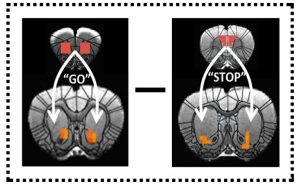
Balance of the “go” and “stop” circuits is disrupted in rats taking drug compulsively. (Image courtesy of Dr. Yuzheng Hu)
Hot Off the Press – May 6, 2019.
We report that in a methamphetamine self-administration experiment, all rats show changes in the balance between “go” and “stop” brain circuits, however after foot shock punishment, behavior in the addictive subgroup is strongly correlated with the change in the balance of “go” and “stop” circuits, while the balance returns towards normal in rats that reduce use after it is paired with punishment, suggesting that non-invasive brain stimulation targeting these circuits in addicts may help restore the go-stop balance and allow individuals to control their drug use.
Publication Information
Compulsive drug use is associated with imbalance of orbitofrontal- and prelimbic-striatal circuits in punishment-resistant individuals. Journal Article
In: Proc Natl Acad Sci U S A, vol. 116, no. 18, pp. 9066–9071, 2019, ISSN: 1091-6490 (Electronic); 0027-8424 (Linking).
